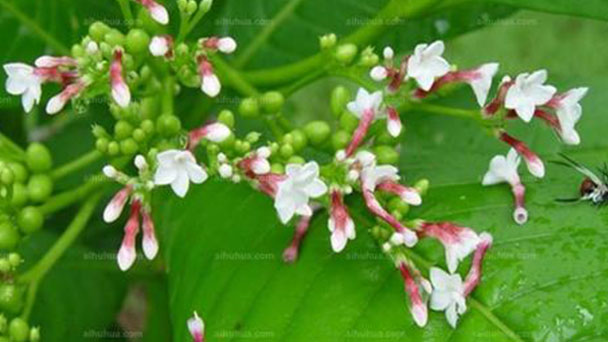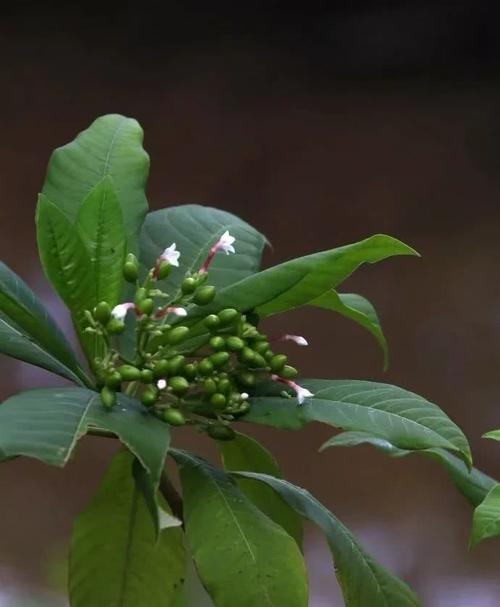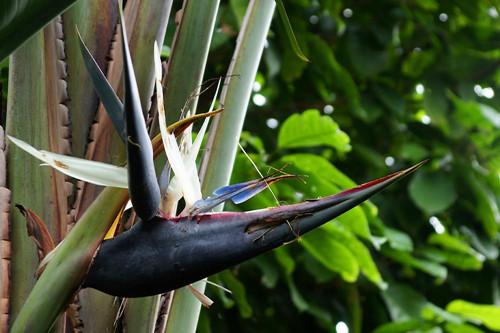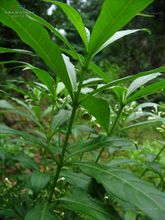Indian snakeroot (Rauvolfia serpentina) profile
Written by Maggie
Mar 24 2021

Indian snakeroot (Rauvolfia serpentina), also known as devil pepper, or serpentine wood, is a shrub up to 60 cm, glabrous except for upper part of inner surface of corolla tube covered with villous hairs; The stem is sparse llickenhole most growth in Gengma, Jinghong wild, born in mountain forest, Xishuangbanna, Kunming and other places are cultivated. Guangdong and Guangxi are also cultivated. Indian snakeroot is distributed in India, Sri Lanka, Burma, Thailand, Indonesia and other regions.
Indian snakeroot picture

Morphological characteristics of Indian snakeroot
The root
Indian snakeroot (devil pepper) is a shrub, 50-60 cm tall, glabrous except for the upper part of the corolla tube covered with villous hairs.
Stems
The stem of Indian Snakeroot (devil pepper) is straw-colored, longitudinally striated, sparsely lenticularized and about 5 mm in diameter. The internodes are 1-4 cm long.
Leaf
Leaves of Indian snakeroot (devil pepper) clustered at upper part of branches, opposite, trifoliate, or 4-vellate, rarely alternate, elliptic lanceolate or obovate, shortly acuminate or acute, base narrowly cuneate or acuminate, 7 -- 17 cm long, 2 -- 5.5 cm wide; Leaf midvein is nearly flat, dorsal midvein protruding, lateral veins 10-12 pairs, arc rising to the front of the leaf margin netted; Petiole is 1-1.5 cm long.
Flowers
Indian snakeroot (devil pepper) is an umbellate or corymbiform cyme, with a single peduncle, distally much branched, 3 -- 13 cm long; Bracteoles are lanceolate, ca. 2 mm long;Peduncle, pedicel, calyx, and corolla tube red; Calyx tube is 3 mm long, lobes 2 mm long; Corolla is saucer-shaped; Corolla tube of Indian snakeroot (devil pepper) is cylindric, central expanded, ca. 10 mm long, lobes white, ovoid, 1.5 mm long and 1 mm wide; Stamens borne at middle of corolla tube, pilose only above where stamens are borne; Disk is annular, ca. Half as high as ovary; Ovary is with 2 carpels, carpels connate to middle, style cylindric, stigma clavate, ovules 2 in each cell.
Fruit
Drupes of Indian snakeroot (devil pepper) in pairs, red, subglobose, connate to middle.
Ecological habits of Indian snakeroot
Indian Snakeroot was born in Gengma and Jinghong mountains and forests.

Distribution area of Indian snakeroot
Indian Snakeroot (devil pepper) is distributed in India, Sri Lanka, Myanmar, Thailand, Indonesia and so on.
Indian snakeroot (devil pepper) is cultivated in Xishuangbanna, Kunming, Guangdong, Guangxi and other places.
Uses of Indian snakeroot
The root of Indian snakeroot (devil pepper) contains more than 28 alkaloids, such as hemopylae and hemopylae, with a total content of 0.5-2%. The leaves, bark and root of Indian snakeroot can be used for medicinal use. It is also used as a folk medicine for fever, seizure, insect and snake bite.Reserpine is the main alkaloid found in the Indian snakeroot root. It lowers blood pressure and slows the heart rate. Its effects are slow, mild and lasting.
Indian Snakeroot (devil pepper) also works against arrhythmias; Because of its vasodilation, it has been thought to be used as an aphrodisiac, but it has not been used in clinical treatment. Reserpine in Indian Snakeroot also has a calming effect on the central nervous system, making it easier to fall asleep, but easier to wake up after sleep, and has significant effects on animal behavior.
Reserpine has an antipsychotic effect in clinic, but the effect is weaker than other targeted drugs, and has not been used in the treatment of psychosis. Indian snakeroot (devil pepper) can increase the hypoglycemic effect of insulin and the hypoglycemic effect of adrenaline in normal subjects. The reserpine contained in Indian snakeroot in the glucose tolerance test inhibited the glycemic response in diabetic patients and also had a hypothermic effect.
The Indian Snakeroot (devil pepper) root wood is toxic to total alkaloids, which can cause toxic symptoms such as vomiting and unstable gait if accidentally hit. Slow and irregular breathing, loss of consciousness similar to deep sleep, death due to respiratory failure. Other side effects include nasal congestion and aggravated peptic ulcer, the latter of which is less common with small doses taken orally.

Latest Updated
- Benefits of Bugleweed - 7 Science-backed Health Benefits
- Bugleweed Dangers & Side Effects - Is It Poisonous?
- How to Plant Evergreen Trees - What You Should Know
- When to Plant Evergreens - Grow Guide for Evergreen Trees
- 12 Wonderful Evergreen Shrubs for Your Garden
- 12 Popular Evergreen Plants with Pictures for Beginners
- When And How To Prune A Lilac Bush Like a Pro
- How to Grow & Care for Lilac Vine (Hardenbergia Violacea)
- Japanese Lilac Tree (Syringa Reticulata) Care & Propagation Guide
- Shumard Oak Pros and Cons - What to Know
Popular Articles
- Winter maintenance of Antirrhinum Majus
- How to Grow Terminalia Mantaly Tree
- How to Grow and Care for Crossostephium Chinense
- How to grow Antirrhinum Majus in spring
- Peristeria Elata (Dove Orchid) Profile: Info & Care Guide
- Underwatered Snake Plant (Sansevieria Trifasciata) - Signs And How To Fix
- How to Care for Brazilian Jasmine Plant (Mandevilla Sanderi)
- How to Grow & Care for Graptopetalum Purple Delight in Summer
- Rosa Chinensis (China Rose): Plant Growing & Care Tips
- How to Care for Baby Sun Rose (Aptenia Cordifolia)